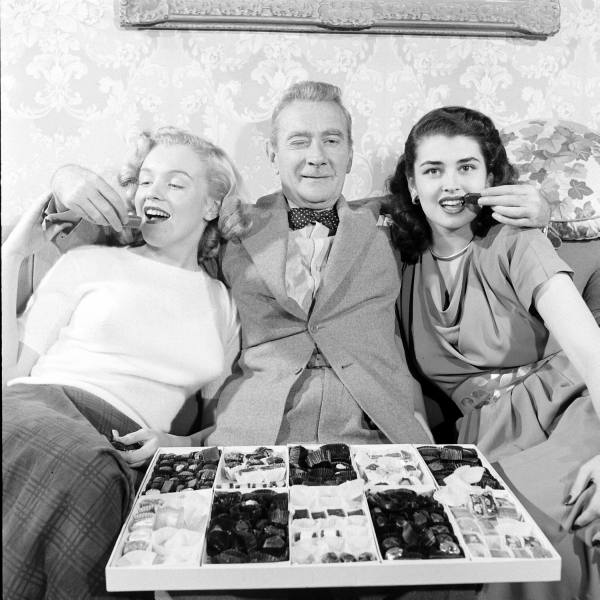
Laurette Luez, a Hawaii-born actress of Portuguese-Australian parentage, seated to Marilyn’s left in these 1949 photos by Philippe Halsman (for a LIFE magazine story, ‘Eight Girls Try Out Mixed Emotions’), is the subject of an interesting profile by Kristin Hunt for JSTOR. (Hunt previously wrote about Marilyn’s nude scene in Something’s Got to Give for Vulture.)
Like Marilyn, Laurette was a successful pin-up model, and in their acting careers, both were subjected to typecasting – Marilyn as a dumb blonde, Luez as a dusky temptress – but like other women of colour, Laurette was sidelined in Hollywood and is now all but forgotten.
In the article, it’s noted that she claimed to have given Norma Jeane her stage name. This is unlikely, however, as Marilyn herself created it with talent scout Ben Lyon in 1946. It’s also said that the starlets studied together, probably at the Actors’ Lab or with studio coach Helen Sorrell. They were first photographed by LIFE‘s Loomis Dean in 1948 with actor Clifton Webb in a rather obscure promotional shoot for his film Sitting Pretty (although neither played a role in it.)

“Laurette Luez first appeared onscreen as a dancing Javanese girl in 1944’s The Story of Dr. Wassell. Two years later, she was cast as a member of the Thai royal court in Anna and the King of Siam, and in 1950 as Laluli, the Indian ‘flower of delight,’ in the Rudyard Kipling epic Kim. For the 1960s films Man-Trap and Flower Drum Song, she played Mexican women. She was Persian in The Adventures of Hajji Baba, an indigenous African in Jungle Gents, and Egyptian in Valley of the Kings.
Like many actresses of her day, Luez was expected to be a one-size-fits-all ‘exotic,’ a beautiful siren in skimpy clothing who could be from almost anywhere—just not here. These roles provided a way for Hollywood to sexualize women with few repercussions from censors or moral crusaders, and they were practically the only parts in which Luez was cast during her 20 years in the industry.
The two actresses were linked again in 1953, when the trade paper Modern Screen wondered if Luez could be the heir to Monroe’s “sex stardom.” But in truth, their careers looked nothing alike … With the occasional exception—most notably, the United Artists noir D.O.A.—her credits consist solely of exoticized, eroticized women, who only get a name if they’re lucky. It was a fate that befell several actresses who couldn’t or wouldn’t pass for white, since there was a market for this type of stock character.
Luez still made occasional headlines throughout the 1950s, either for her latest movie or for her latest breakup. She was married four times, and briefly engaged to producer Samuel Goldwyn Jr. But by the mid-1960s, the work had completely dried up. Luez packed up her family and moved to Florida. Despite the repeated insistence from the press that she was on the cusp of stardom, the actress got trapped in a self-perpetuating cycle: she played the roles she was offered, and Hollywood saw her as nothing else.”